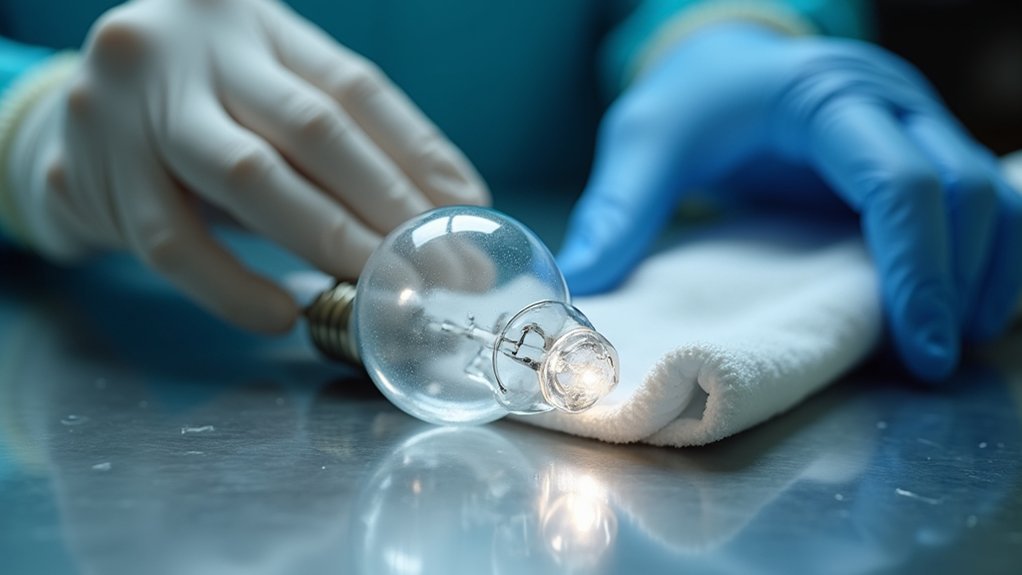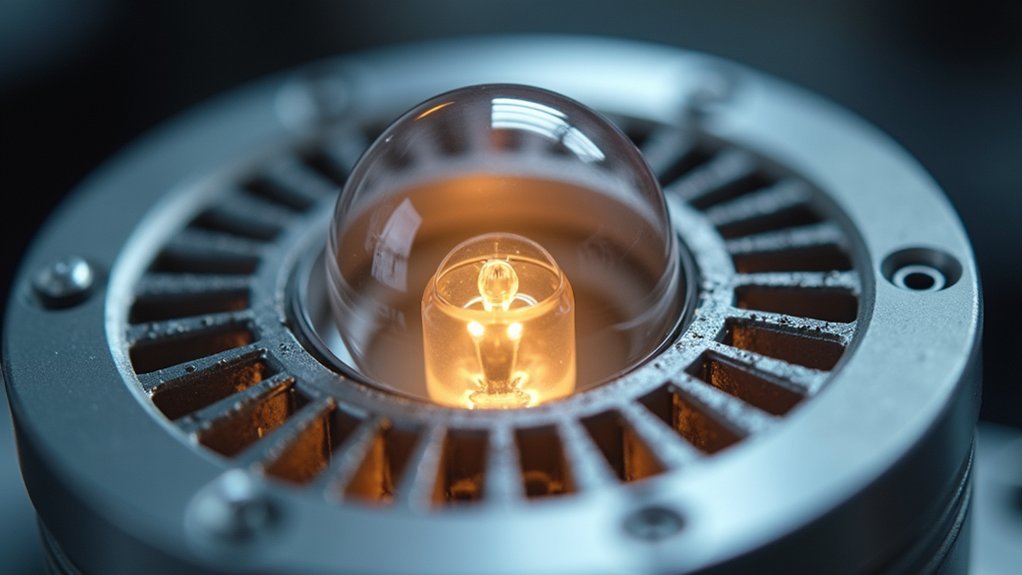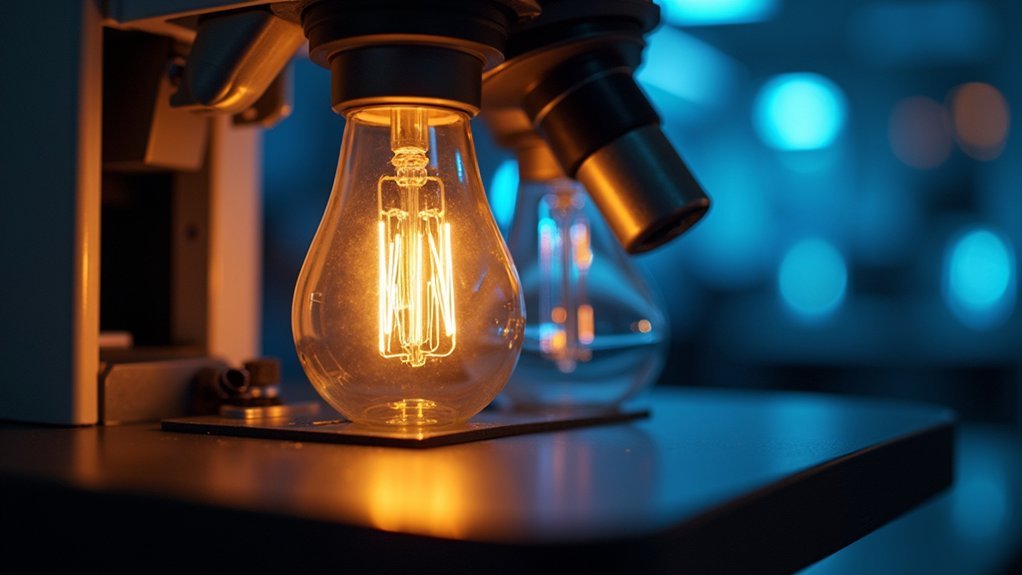To extend your halogen bulb’s lifespan, handle it with clean gloves or paper towels to prevent oils on the glass. Operate at rated voltage, ideally with a compatible dimmer set to 90-95% of mains voltage. Verify proper ventilation and clean fixtures regularly to improve heat dissipation. Position bulbs correctly and check for corrosion or poor connections. Tighten connections periodically to prevent flickering. These simple practices can transform your experience from frequent replacements to long-lasting illumination.
Proper Handling and Installation Techniques for Microscope Halogen Bulbs

When installing halogen bulbs in your microscope, you’ll need to follow specific handling procedures to guarantee maximum lifespan.
Always use clean paper towels or gloves during proper handling to prevent finger oils from contaminating the glass surface. These oils create hot spots that can cause premature failure.
Ensure you’re positioning the bulb correctly and level within its fixture to extend the life of the filament by avoiding temperature stress.
Never touch the glass directly—this can lead to breakage or uneven heating that shortens bulb life.
Regularly inspect the lamp holder for corrosion or poor electrical connections that might cause damaging voltage spikes.
Consider installing a compatible dimmer to reduce voltage during operation, further extending your bulb’s operational lifespan.
Optimal Voltage Management to Extend Bulb Life
Although microscope halogen bulbs are designed to withstand specific operating conditions, managing voltage properly remains crucial for maximizing their lifespan. Your halogen bulbs should operate at their rated voltage (typically 12V) to prevent premature burnout. Higher voltage increases power consumption and heat generation, greatly shortening bulb life.
Proper voltage management prevents premature burnout and extends the life of your microscope halogen bulbs.
Monitor your home voltage levels consistently, as voltage spikes can instantly damage the filament. Consider installing a resistor to limit excess current and prevent overheating.
If you’re using dimmers, verify they’re compatible with halogen bulbs and set them to 90-95% of mains voltage for ideal voltage management.
Don’t overlook proper electrical connections during installation. Eliminating voltage inconsistencies through careful setup will extend bulb life considerably, saving you money on replacements while guaranteeing consistent illumination performance.
Heat Dissipation Strategies for Microscope Light Sources

Heat management represents the next frontier in preserving your halogen bulb’s lifespan. Proper ventilation around your microscope’s light source greatly reduces operating temperatures, preventing premature burnout from heat stress. You’ll extend your halogen’s life by ensuring air can freely circulate around the housing.
Install heat sinks or small fans to enhance heat dissipation and maintain ideal operating temperatures. Position your bulb at angles that improve airflow, allowing heat to escape more efficiently from the surface.
Don’t overlook regular cleaning of the light housing—dust accumulation restricts airflow and traps heat, severely shortening bulb life.
Consider implementing a dimming system to reduce power input while maintaining adequate illumination. This simple adjustment decreases heat generation while providing sufficient light for your microscopic work.
Cleaning and Maintenance Routines for Halogen Illumination Systems
Regular maintenance of your halogen illumination system directly impacts both performance and longevity. Wipe bulbs with a lint-free cloth to remove fingerprints and oils that cause overheating and shorten lifespan. Periodically check and tighten connections to prevent flickering and premature burnout.
| Maintenance Task | Benefit to System |
|---|---|
| Fingerprint removal | Prevents hotspots and cracking |
| Connection tightening | Eliminates flickering issues |
| Dust removal | Improves heat dissipation |
| Moisture inspection | Prevents corrosion damage |
| Fixture securing | Reduces filament stress |
Keep fixtures free from dust and debris that trap heat and diminish performance. Don’t overlook regular inspections for water damage, as moisture leads to corrosion. By implementing these simple cleaning and maintenance routines, you’ll markedly extend your halogen bulbs’ lifespan while ensuring ideal illumination quality.
Alternatives and Upgrades to Traditional Halogen Microscope Lighting

Three compelling alternatives to traditional halogen microscope lighting have emerged in recent years, with LED technology leading the revolution.
You’ll find LED lighting offers dramatically longer life spans—up to 50,000 hours compared to halogen’s meager 500-1,000 hours—significantly reducing your replacement costs and maintenance time.
Beyond longevity, LED alternatives provide practical advantages for your microscopy work.
They generate less heat, protecting sensitive specimens and components from thermal damage. You’ll appreciate the adjustable brightness and color temperature options that aren’t available with traditional halogen systems.
For labs seeking greater efficiency, LEDs consume substantially less power while delivering superior luminosity and improved color rendering.
This combination of energy savings, enhanced image clarity, and reduced maintenance makes LED technology the most practical upgrade path for your microscope lighting system.
Frequently Asked Questions
Why Do Halogen Bulbs Burn Out so Quickly?
Your halogen bulbs burn out quickly due to overvoltage, fingerprint oils causing hot spots, vibration damage to filaments, and frequent on/off cycling. These factors stress the delicate components, drastically reducing their expected 500-1000 hour lifespan.
How Long Should a Halogen Bulb Last?
Your halogen bulb should last between 500 to 1,000 hours with normal use. You’ll get the most life if you don’t touch the glass, avoid voltage fluctuations, and keep fixtures clean from dust.
Is It Worth Replacing Halogen With LED?
Yes, it’s worth replacing halogen with LED. You’ll save money long-term through reduced energy costs and fewer replacements. LEDs last up to 50 times longer, run cooler, and provide better light quality.
What Helps Light Bulbs Last Longer?
You’ll extend your light bulbs’ lifespan by operating them at rated voltage, turning them off when unused, keeping them clean, using compatible dimmers, and ensuring proper fixture connections with minimal vibration. These habits reduce stress on filaments.
In Summary
You’ll extend your microscope’s halogen bulb life with proper handling and voltage management. Don’t touch the glass with bare fingers, and always operate at recommended voltages. Verify your microscope has adequate ventilation, and clean the light housing regularly. Routine maintenance prevents premature burnout. When it’s time for replacement, consider LED alternatives that offer longer life and cooler operation for your microscopic explorations.





Leave a Reply